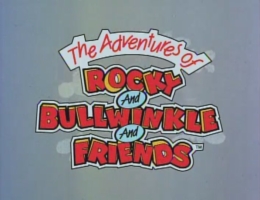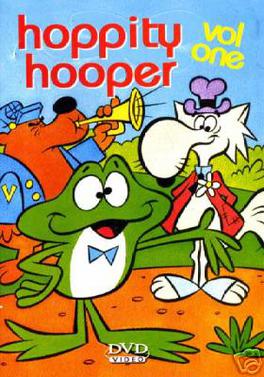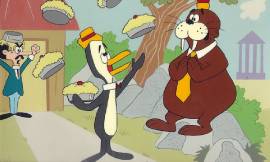
The Adventures of Rocky and Bullwinkle and Friends is an American animated television series that originally aired from November 19, 1959, to June 27, 1964, on the ABC and NBC television networks. Produced by Jay Ward Productions, the series is structured as a variety show, with the main feature being the serialized adventures of the two title characters, the anthropomorphic flying squirrel Rocket J. ("Rocky") Squirrel and moose Bullwinkle J. Moose. The main antagonists in most of their adventures are the two Russian-like spies Boris Badenov and Natasha Fatale, both working for the Nazi-like dictator Fearless Leader. Supporting segments include "Dudley Do-Right", "Peabody's Improbable History", and "Fractured Fairy Tales", among others. The current blanket title was imposed for home video releases more than 40 years after the series originally aired and was never used when the show was televised; television airings of the show were broadcast under the titles of Rocky and His Friends from 1959 to 1961, The Bullwinkle Show from 1961 to 1964, and The Rocky and Bullwinkle Show in syndication.
Animation in the United States in the television era was a period in the history of American animation that slowly set in with the decline of theatrical animated shorts and the popularization of television animation that started in 1956, reached its peak during the 1970s (1970-1971-1972-1973-1974-1975-1976-1977-1978-1979), and ended around in 1985. This era is characterized by low budgets, limited animation, an emphasis on television over the theater, and the general perception of cartoons being primarily for children. Due to the perceived cheap production values, poor animation, and mixed critical and commercial reception, the era is generally looked back upon negatively by critics and animation historians. The television animation of this period is often referred to as the dark age of American animation, while the theatrical animation from the time is sometimes referred as the bronze age.

Joseph Ward Cohen Jr., also known as Jay Ward, was an American creator and producer of animated TV cartoon shows. He produced animated series based on such characters as Crusader Rabbit, Rocky & Bullwinkle, Dudley Do-Right, Peabody and Sherman, Hoppity Hooper, George of the Jungle, Tom Slick, and Super Chicken. His own company, Jay Ward Productions, designed the trademark characters for the Cap'n Crunch, Quisp, and Quake breakfast cereals and it made TV commercials for those products. Ward produced the non-animated series Fractured Flickers (1963) that featured comedic redubbing of silent films.

Dudley Do-Right is a fictional character created by Alex Anderson, Chris Hayward, Allan Burns, Jay Ward, and Bill Scott, who appears as the main protagonist of "Dudley Do-Right of the Mounties", a segment on The Rocky and Bullwinkle Show.

Hoppity Hooper is an American animated television series produced by Jay Ward, and sponsored by General Mills, originally broadcast on ABC from September 12, 1964, until 1967. The series was produced in Hollywood by Jay Ward and Bill Scott, with animation done in Mexico City by Gamma Productions.

Calvin and the Colonel is an American animated sitcom about Colonel Montgomery J. Klaxon, a shrewd fox, and Calvin T. Burnside, a dumb bear. Their lawyer was Oliver Wendell Clutch, who was a (literal) weasel. The colonel lived with his wife Maggie Belle and her sister Susan Culpepper, who did not trust the Colonel at all. Colonel Klaxon was in the real estate business, but always tried get-rich-quick schemes with Calvin's unwitting help.

The Adventures of Gulliver is a 1968 television cartoon produced by Hanna-Barbera Productions. The show is loosely based on the 1726 satirical novel Gulliver's Travels by Jonathan Swift. The show aired Saturday mornings on ABC-TV and lasted for one season in its original broadcast. Flirtacia appeared in the third season of Jellystone!.

Jay Ward Productions, Inc. is an American animation studio based in Costa Mesa, California. It was founded in 1948 by American animator Jay Ward. As of 2022, the studio was headed by Ward's daughter, Tiffany Ward, and granddaughter, vice president Amber Ward.
Alexander Hume Anderson Jr. was an American cartoonist who created the characters of Rocky the Flying Squirrel, Bullwinkle, and Dudley Do-Right, as well as Crusader Rabbit. He was not directly involved in The Rocky and Bullwinkle Show, however.
Casper and the Angels is an American animated television series based on the Harvey Comics cartoon character Casper the Friendly Ghost, produced by Hanna-Barbera Productions and broadcast on NBC from September 22 to December 15, 1979.
The New Shmoo is an American animated television series based on the character from the Li'l Abner comic strip created by Al Capp, produced by Hanna-Barbera Productions and broadcast on NBC from September 22 to December 15, 1979.
The Houndcats is an American Saturday morning cartoon series produced by DePatie–Freleng Enterprises. The series was broadcast by NBC from September 9 to December 2, 1972, with reruns continuing until September 1, 1973. Thirteen episodes were produced.

The Flintstone Comedy Hour is an American animated television series and a spin-off of The Flintstones and The Pebbles and Bamm-Bamm Show, produced by Hanna-Barbera, which aired on CBS from September 9, 1972, to September 1, 1973. It was re-titled The Flintstone Comedy Show for a second season of reruns as a half-hour show from September 8, 1973, to January 26, 1974.

Tennessee Tuxedo and His Tales is an animated television series that originally aired Saturday mornings on CBS from 1963 to 1966 as one of the earliest Saturday morning cartoons. It was produced by Total Television, the same company that produced the earlier King Leonardo and the later Underdog, and primarily sponsored by General Mills. A co-sponsor was Pillsbury's Funny Face Drinks. The title is a play on the “tuxedo” dinner jacket worn as formal wear.
Events in 2010 in animation.
Events in 1959 in animation.
Events in 1961 in animation.
Events in 1954 in animation.
Events in 1920 in animation.
Events in 1917 in animation.









